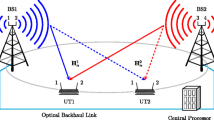Abstract
Transmit antenna diversity and single user spatial multiplexing have become attractive in practical systems, because they achieve performance gains without requiring sophisticated channel state information (CSI) feedback mechanisms. On the other hand, when fast and accurate CSI at the transmitter is available, opportunistic power control (OPC) is an attractive alternative to signal-to-interference-and-noise ratio (SINR) target following approaches, because it maximizes throughput by taking advantage of fast channel variations. In this paper we examine the question whether OPC is worth the pain of obtaining fast CSI by evaluating the gains of OPC for the downlink of a system employing multiple input multiple output (MIMO) systems with Alamouti and open loop spatial multiplexing (SM). We formulate the OPC problem as a throughput maximization task subject to power budget and fairness constraints. We solve this task by the Augmented Lagrangian Penalty Function and find that without fairness constraints, OPC in concert with SM provides superior throughput. With increasingly tight fairness constraints, Alamouti along with equal power allocation becomes a viable alternative to the SM OPC scheme. Both from fairness and throughput perspectives, Alamouti along with OPC is particularly efficient when adaptive MCS is employed and users with large differences in channel qualities have to share the total transmit power.
Similar content being viewed by others
References
Knopp, R., & Humblet, P. A. (1995). Information capacity and power control in single cell multiuser communications. IEEE international conference on communications, ICC’95. doi:10.1109/ICC.1995.525188.
Leung K-K., Sung C.W. (2006) An opportunistic power control algorithm for cellular network. IEEE Transactions on Networking 14(3): 470–478
Hande P., Rangan S., Chiang M., Wu X. (2008) Distributed uplink power control for optimal SIR assignment in cellular data networks. IEEE Transactions on Networking 16(6): 1420–1433
Fodor, G., Johansson, M., & Soldati, P. (2010) Near optimum power control and precoding under fairness constraints in network MIMO systems. International Journal of Digital Multimedia Broadcasting. doi:10.1155/2010/251719.
Reider, N., Fodor, G., & Rácz, A. (2010). Opportunistic target SINR setting for the MIMO broadcast channel. 16th European wireless conference. doi:10.1109/EW.2010.5483406.
Zheng L., Tse D. N. (2003) Diversity and multiplexing: A fundamental tradeoff in multiple antenna channels. IEEE Transactions on Information Theory 49(5): 1073–1096
Lim, A. W. C., & Lau, V. K. N. (2006). On the fundamental tradeoff of spatial diversity and spatial multiplexing of MIMO links with imperfect CSIT. IEEE international symposium on information theory doi:10.1109/ISIT.2006.262145.
Alamouti S. M. (1998) A simple transmit diversity technique for wireless communication. IEEE Journal on Selected Areas in Communications 16: 1451–1458
Bhatti M. A. (2000) Practical optimization methods: With mathematica applications. Springer, New York
Stupia, I., Giannetti, F., Lottici, V., & Vandendorpe, L. (2009). A novel link performance prediction method for coded MIMO-OFDM systems. IEEE wireless communications and networking conference, WCNC’09. doi:10.1109/WCNC.2009.4917526.
Kay S. M. (1993) Fundamentals of statistical signal processing: Estimation theory. Englewood Cliffs, Prentice-Hall, NJ
Dai H., Molisch A. F., Poor H. V. (2004) Downlink capacity of interference-limited MIMO systems with joint detection. IEEE Transactions on Wireless Communication 3(2): 442–453
Chen R., Andrews J. G., Heath R. W., Ghosh A. (2007) Uplink power control in multi-cell spatial multiplexing wireless systems. IEEE Transactions on Wireless Communications 6(7): 2700–2711
Simoens S., Rouquette-Leveil S., Sartori P., Blankenship Y., Classom B. (2006) Error prediction for adaptive modulation and coding in multiple-antenna OFDM systems. Signal Processing Elsevier 86(8): 1911–1919
Brüninghaus, K., Astely, D., Sälzer, T., Visuri, S., Alexiu, A., Karger, S., et al. (2005). Link performance models for system level simulations of broadband radio access systems. IEEE 16th international symposium on personal, indoor and mobile radio communications, PIMRC’05. doi:10.1109/PIMRC.2005.1651855.
Proakis J. (2000) Digital communications. 4th edn. McGraw-Hill Press, New York
Wan, L., Tsai, S., & Almgren, M. (2006). A fading-insensitive performance metric for a unified link quality model. IEEE wireless communications and networking conference, WCNC’06. doi:10.1109/WCNC.2006.1696622.
Rácz, A., Reider, N., & Fodor, G. (2008). On the impact of inter-cell interference in LTE. IEEE 50th global communications conference, GLOBECOM’08. doi:10.1109/GLOCOM.2008.ECP.1038.
Reider, N., Rácz, A., & Fodor, G. (2009). On scheduling and power control in multi-cell coordinated clusters. IEEE 51st global communications conference GLOBECOM’09. doi:10.1109/GLOCOM.2009.5425622.
Jain, R. K., Chiu, D.-M. W., & Hawe, W. R. (1984). A quantitative measure of fairness and discrimination for resource allocation and shared computer system. Technical report DEC-TR-301. Digital Equipment Corporation.
Boyd S., Vandenberghe L. (2004) Convex optimization. Cambridge University Press, Cambridge
Bazaraa M. S., Sherali H. D., Shetty C. M. (2006) Nonlinear programming: Theory and algorithms. Wiley, London
Author information
Authors and Affiliations
Corresponding author
Additional information
This work is a substantially extended version of a paper published at the 6th IEEE Workshop on Broadband Wireless Access, Miami, FL, USA, December 6 2010.
Rights and permissions
About this article
Cite this article
Reider, N., Fodor, G. On Opportunistic Power Control for Alamouti and SM MIMO Systems. Wireless Pers Commun 67, 335–358 (2012). https://doi.org/10.1007/s11277-011-0381-9
Published:
Issue Date:
DOI: https://doi.org/10.1007/s11277-011-0381-9




